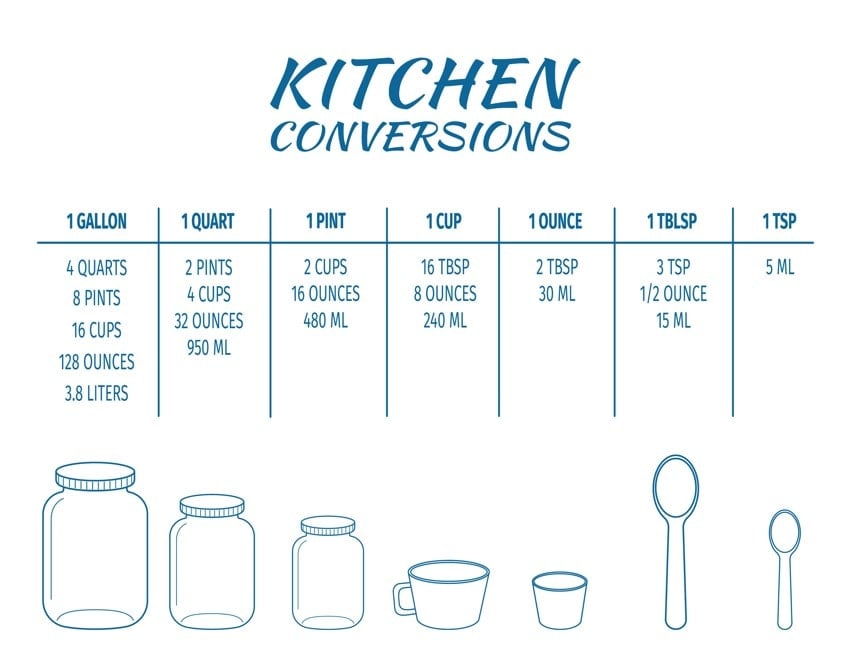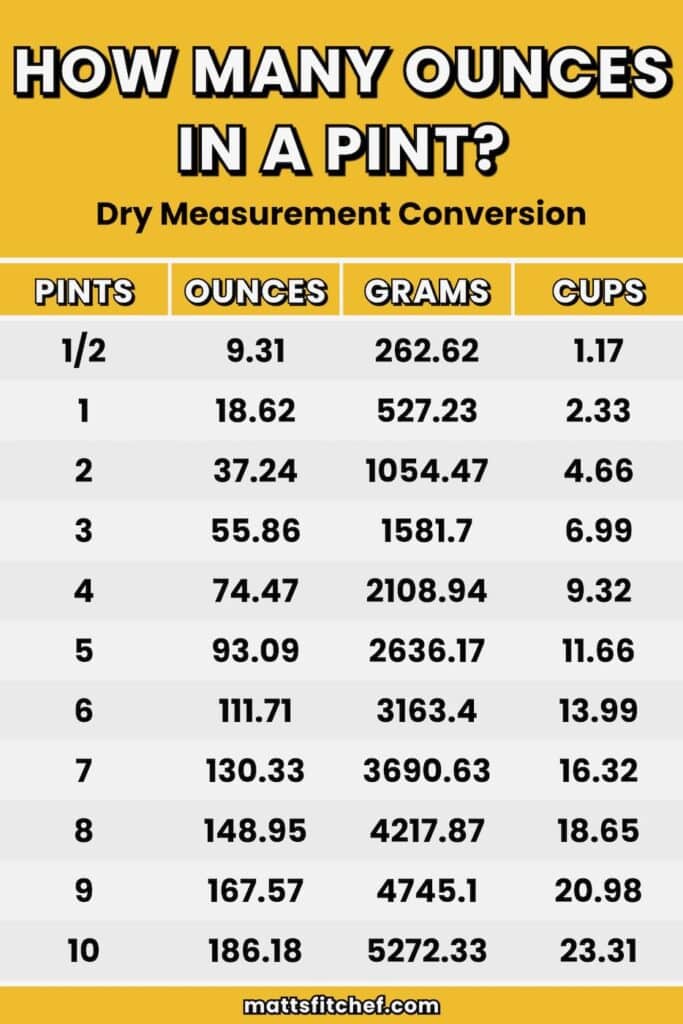How Many Ounces Make A Pint? Let’s Dive Into The Liquid Math
Alright, let’s spill the beans—how many ounces make a pint? If you’ve ever found yourself scratching your head at the grocery store, wondering whether that pint of milk is enough for your recipe, you’re not alone. This question pops up more often than you think, especially when you’re dealing with liquid measurements in the kitchen or at the bar. Whether you’re baking a cake or ordering a cold brew, understanding the ounce-to-pint conversion is a game-changer.
Let’s face it, measurements can be tricky, especially when we’re switching between different systems. The good ol’ imperial system and its metric counterpart can sometimes feel like they’re speaking different languages. But don’t worry, by the end of this article, you’ll have all the answers you need. We’ll break it down step by step so you can confidently measure liquids like a pro.
Now, before we dive deeper, let’s set the stage. A pint is a unit of measurement commonly used in the United States and the UK, but here’s the twist—it’s not the same in both places. Yep, you heard that right! The US pint and the UK pint differ slightly, and we’ll get to that in a bit. So, buckle up, and let’s crack this measurement mystery together.
- Latest 300 Your Ultimate Guide To Staying Updated In The Fastpaced World
- Unveiling The Enigma Everything You Need To Know About Jonathan Oddi
Understanding the Basics: What is a Pint?
Before we jump into the ounce game, let’s talk about what a pint actually is. A pint is a unit of volume used to measure liquids. It’s like the middle child of liquid measurements—bigger than a cup but smaller than a quart. Depending on where you are in the world, a pint can vary in size. In the US, a pint equals 16 fluid ounces, while in the UK, it’s slightly larger at 20 fluid ounces. Crazy, right?
Here’s a quick breakdown:
- US Pint = 16 fluid ounces
- UK Pint = 20 fluid ounces
So, if you’re traveling or cooking with recipes from across the pond, keep this difference in mind. It might save you from a baking disaster or an overly strong cocktail.
- Johnnie Cochran Net Worth At Death Unveiling The Legacy Of A Legal Legend
- Hyde Wednesday The Ultimate Guide To Unveiling The Mystery
How Many Ounces Make a Pint? The Math Explained
Alright, time to crunch some numbers. To answer the burning question, how many ounces make a pint, we need to do a little math. Don’t worry, it’s not rocket science. In the US, a pint is equal to 16 fluid ounces. Simple as that. But if you’re dealing with the UK pint, you’ll need to account for 20 fluid ounces. Let’s break it down further:
US Pint Conversion
In the United States, the pint is standardized at 16 fluid ounces. This means that if you’re measuring liquids using the US system, every pint you come across will have exactly 16 ounces. Whether you’re pouring milk, beer, or juice, the math stays the same.
UK Pint Conversion
On the other side of the pond, things get a little more interesting. In the UK, a pint is slightly larger, coming in at 20 fluid ounces. This difference might seem small, but it can make a big impact when you’re working with precise measurements. So, if you’re following a UK recipe, make sure to adjust accordingly.
Why Does the Difference Matter?
Now you might be wondering, why does this difference even matter? Well, it matters a lot if you’re someone who takes their measurements seriously. Imagine baking a cake and using a US pint instead of a UK pint—or vice versa. The results could be disastrous. Too much liquid can ruin your batter, and too little can leave your cake dry and crumbly.
Even in the world of cocktails, the pint difference can affect the strength of your drink. A pint of beer in the UK is going to be stronger than its US counterpart because it contains more liquid. So, next time you’re sipping on a pint, consider where it came from and how it measures up.
Common Misconceptions About Pints
There are a few common misconceptions floating around when it comes to pints. Some people think that all pints are created equal, but as we’ve learned, that’s not the case. Others believe that a pint is just a pint, no matter what you’re measuring. Wrong again! The type of liquid you’re measuring can also affect the weight and volume of a pint.
For example, a pint of water weighs differently than a pint of milk or beer. This is because different liquids have different densities. So, while the volume might be the same, the weight can vary. Always keep this in mind when you’re measuring liquids for cooking or bartending.
Practical Applications of Pint Measurements
Now that we’ve covered the basics, let’s talk about how this knowledge can be applied in real life. Whether you’re a home cook, a professional chef, or a bartender, understanding pint measurements can make your life a whole lot easier.
For Home Cooks
If you’re cooking at home, having a clear understanding of pint measurements can help you follow recipes more accurately. Whether you’re making soup, stew, or a batch of homemade ice cream, knowing how many ounces are in a pint can prevent overfilling or underfilling your pots and pans.
For Bartenders
Bartenders, listen up! Knowing the difference between US and UK pints can help you craft the perfect drink every time. Whether you’re pouring a pint of beer or mixing up a cocktail, precise measurements are key to creating a great-tasting beverage.
Converting Pints to Other Units
While we’re on the topic of pints, let’s talk about converting them to other units of measurement. Sometimes, recipes call for cups, tablespoons, or milliliters instead of pints. Here’s a quick conversion guide to help you out:
- 1 US Pint = 2 Cups
- 1 US Pint = 32 Tablespoons
- 1 US Pint ≈ 473 Milliliters
And for our UK friends:
- 1 UK Pint = 2.402 Cups
- 1 UK Pint = 40 Tablespoons
- 1 UK Pint ≈ 568 Milliliters
These conversions can come in handy when you’re working with recipes from different parts of the world.
Real-World Examples of Pint Usage
To give you a better idea of how pints are used in everyday life, let’s look at some real-world examples. Whether you’re at a restaurant, a bar, or a grocery store, pints are everywhere.
Restaurant Recipes
Restaurants often use pints as a standard unit of measurement for soups, stews, and sauces. This ensures consistency across all dishes, no matter who’s cooking them. Knowing how many ounces are in a pint can help chefs scale recipes up or down depending on the size of the batch.
Bar Beverages
At the bar, pints are the go-to unit for serving beer, cider, and other alcoholic beverages. A pint of beer in the US is a refreshing 16 ounces, while a UK pint offers a little extra kick with its 20 ounces. Understanding these differences can help you make informed choices when ordering your favorite drinks.
Tips for Accurate Measurements
Now that you know how many ounces make a pint, here are a few tips to help you measure liquids accurately:
- Use a measuring cup with clear markings for ounces and milliliters.
- Level off the liquid at eye level to ensure precision.
- Double-check your conversions if you’re working with recipes from different countries.
By following these tips, you’ll be able to measure liquids like a pro and avoid any kitchen mishaps.
Conclusion: Mastering the Art of Pint Measurement
So, there you have it—how many ounces make a pint, and why it matters. Whether you’re cooking, bartending, or just trying to impress your friends with your measurement knowledge, understanding this conversion can take you a long way. Remember, a US pint equals 16 fluid ounces, while a UK pint equals 20 fluid ounces. Keep this difference in mind, and you’ll never go wrong.
Now it’s your turn! Share this article with your friends, leave a comment with your own measurement tips, or try out some recipes that call for pint measurements. The more you practice, the better you’ll get. Happy measuring, and cheers to mastering the art of liquid math!
Table of Contents
- Understanding the Basics: What is a Pint?
- How Many Ounces Make a Pint? The Math Explained
- Why Does the Difference Matter?
- Common Misconceptions About Pints
- Practical Applications of Pint Measurements
- Converting Pints to Other Units
- Real-World Examples of Pint Usage
- Tips for Accurate Measurements
- Conclusion: Mastering the Art of Pint Measurement
And that’s a wrap! Thanks for joining me on this pint-sized adventure. Cheers!



Detail Author:
- Name : Emiliano Berge
- Username : rick.herman
- Email : tina48@hotmail.com
- Birthdate : 1982-01-16
- Address : 741 King Skyway West Rosettatown, ND 25904
- Phone : (657) 231-0291
- Company : Spencer and Sons
- Job : Freight Agent
- Bio : Animi iste asperiores cumque quia molestias necessitatibus. Quae est vel optio non maiores.
Socials
facebook:
- url : https://facebook.com/khalid.morar
- username : khalid.morar
- bio : Ipsum voluptatum rerum officia placeat voluptates quaerat.
- followers : 982
- following : 2388
linkedin:
- url : https://linkedin.com/in/khalid_morar
- username : khalid_morar
- bio : Cumque rerum libero at id similique.
- followers : 176
- following : 1272
instagram:
- url : https://instagram.com/khalid8723
- username : khalid8723
- bio : Sit eum dolorem unde. Velit quia ut nisi maiores eius. Placeat culpa omnis corrupti omnis et.
- followers : 2571
- following : 1008
twitter:
- url : https://twitter.com/khalid9994
- username : khalid9994
- bio : Et dignissimos aliquid alias qui non voluptatem eum. Ab fuga explicabo aspernatur id sit. Enim quae ut sint sequi voluptatem nam delectus.
- followers : 3050
- following : 1850
tiktok:
- url : https://tiktok.com/@khalid.morar
- username : khalid.morar
- bio : Et occaecati dolorum dicta similique sapiente.
- followers : 2978
- following : 231